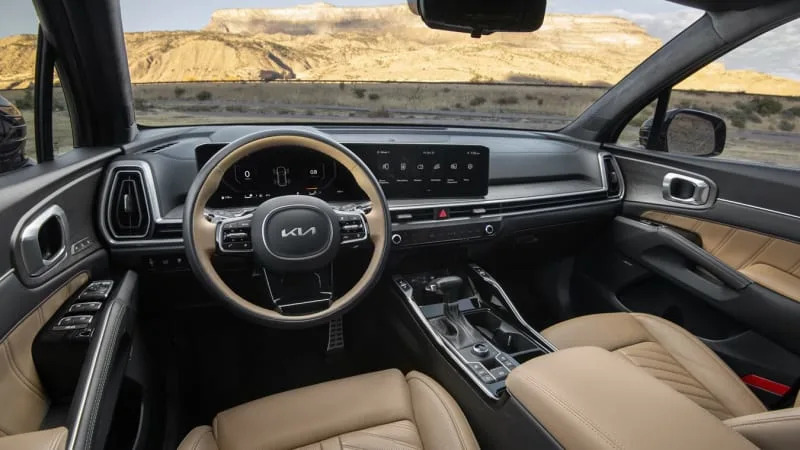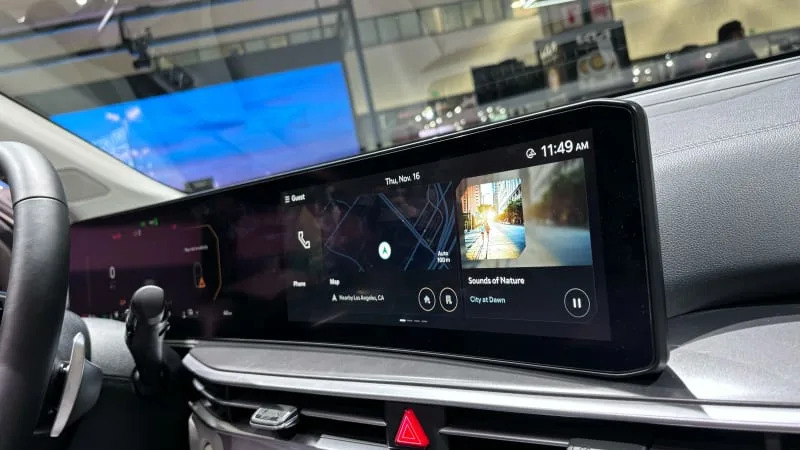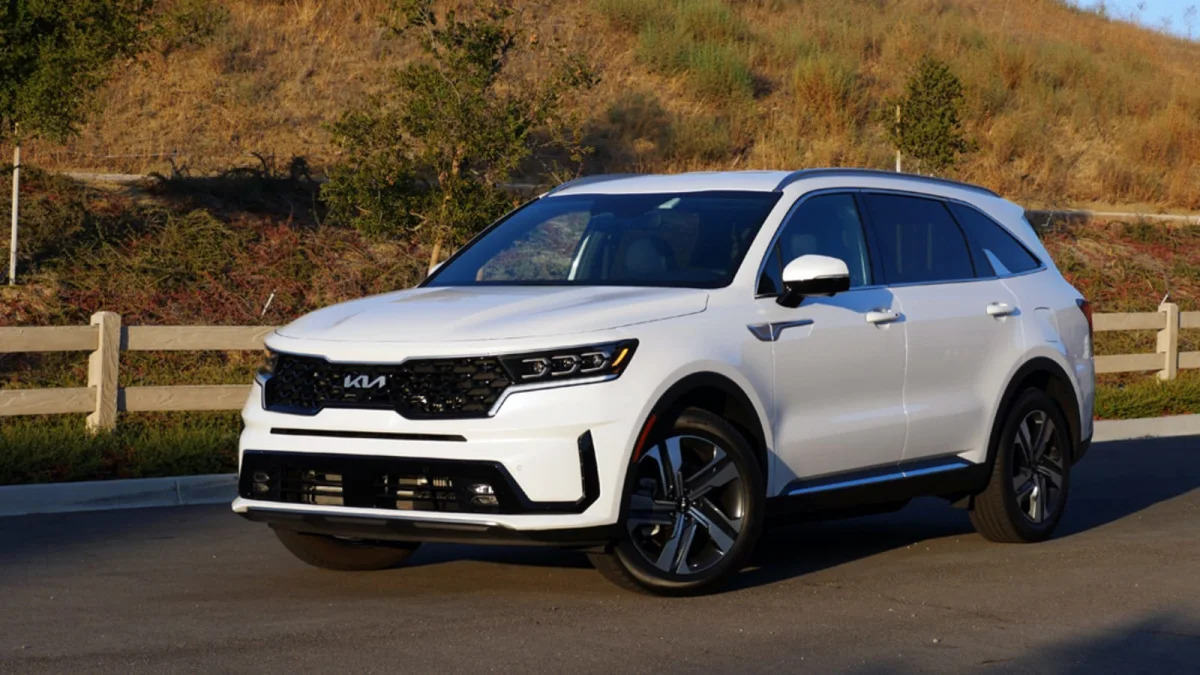2024 Kia Sorento Review: The tale of two Sorentos

Pros: Available hybrids; dimensions may be ‘Goldilocks’ just-right size for many; excellent tech
Cons: Slow base engine; hybrids don’t get updated for 2024; cramped third row for a three-row SUV
The Kia Sorento has been updated extensively for 2024. It also carries over mostly unchanged. Huh?
You see, the versions powered only by gasoline get a litany of updates and upgrades, including bolder styling, a new tech interface encased within a slick curved housing, additional features and a new X-Pro rugged trim level. The 2024 Kia Sorento Hybrid and Plug-in Hybrid don’t get any of that, and are the same midsize, three-row SUV you could get last model year. They’ll be getting the same updates, minus the X-Pro, for 2025.
So, the question must be asked: Should you wait for them? We have not fully tested an updated 2024 Sorento, but we have seen it in person, including the interior, and while the cabin certainly has more of a “wow” factor with that big, wrap-around panel, it’s not a substantial leap over what was already pretty great. The Sorento had (and the hybrids continue to have) one of the best in-car technology suites around – it’s not out of the realm of possibility that the new system could be worse in some ways. Wouldn’t be the first time that’s happened. There also aren’t any noteworthy mechanical updates, apart from the off-road-oriented X-Pro, so the 2024 Sorento should theoretically drive the same. The hybrids will drive exactly the same, which is just fine.
Ultimately, we feel safe in saying that the 2024 Kia Sorento will remain one of our top-recommended three-row SUVs. We’re positive about the hybrids, especially as electrified family vehicles are so rare. We appreciate every Sorento’s in-betweener size for those who need more space and seating than two-row compacts offer but don’t want to go all the way up to Telluride-sized family haulers. In general, the Sorento is very well-rounded, which the updates shouldn’t change … regardless of when they occur.
Interior & Technology | Passenger & Cargo Space | Performance & Fuel Economy
What it’s like to drive | Pricing & Trim Levels | Crash Ratings & Safety Features
2025 Kia Sorento PHEV and 2024 Kia Sorento PHEV
What’s new for 2024?
The gas-only Sorento trims get new front styling and mildly refreshed rear styling. Inside, there’s a new infotainment system with a next-generation user interface, bigger screens encased in a single curved housing and wireless Apple/Android connectivity across the board. A new X-Pro trim level debuts, building upon the existing X-Line with BF Goodrich all-terrain tires wrapping 17-inch wheels. You can read more about these changes in our 2024 Kia Sorento preview.
The Sorento Hybrid and Plug-In Hybrid effectively carry over unchanged for 2024, but will get the above style and infotainment updates for 2025. You can see the visual changes above.


What are the Sorento interior and in-car technology like?
As noted above, the interior differs based on powertrain. The updated design (above in tan) is sleeker, with slim door-to-door air vents, touch-sensitive menu buttons and a wow-moment curved infotainment panel. The hybrids’ carry-over design (above in white and blue) features eight air vents, physical buttons, a traditional instrument binnacle and dash-top screen. It definitely doesn’t look as good, but we also thought it looked pretty good before and still do. Those touch-sensitive menu buttons are also a love-‘em-or-hate-‘em feature in other Kias (the hate-‘em group seems to be people who frequently adjust the climate control system), so depending on your point of view, functionality could actually be worse. The Sorento’s high-quality materials and solid build quality are the same with both, though.
Technology is totally different. The Hybrid gets traditional gauges standard on the EX and an all-digital instrument panel on the SX. Both get the same 10.25-inch infotainment screen that runs a user-friendly, feature-packed interface that’s more modern than a lot of other carmakers’ infotainment systems. We haven’t had any substantial experience with the new interface found in the updated gas-only versions, but its design is obviously a departure and its functionality could be fundamentally different as a result. It could certainly be worse, if not for all users, then some. Either way, the updated system is supported by a 12.3-inch infotainment screen. A second 12.3-inch screen is used for the instrument panel in the SX and SX Prestige. It seems like there are still analog gauges for the LX, S and EX trim levels, but we have yet to see photos about how that’ll work with the new curved screen housing.




How big is the Sorento?
The Sorento has three rows of seats and is considered a midsize crossover, but it’s considerably smaller than other vehicles described as such. It’s 8 inches shorter in length than the Telluride and 4 inches narrower, which is significant. It also has nearly 2 fewer inches of third-row legroom (plus a seat that’s much closer to the floor and therefore less comfortable) and 3.1 fewer inches of middle-row shoulder room. Those are two dimensions most likely to make a difference when loading up with people. All that said, the Telluride is one of the biggest vehicles in the segment, and the Sorento isn’t that far off the pace. It even has more third-row space than the Toyota Highlander. It’s also important to note the Sorento has basically the same exterior dimensions as two-row midsize crossovers – in that way, the third row can basically be thought of as a bonus feature for occasional use.
One thing to keep in mind: A second-row bench seat is optional on most trims, meaning there is frequently only six seats aboard with the second-row captain’s chairs and two-person third row. Most three-row crossovers these days have seatbelts for seven or eight depending on the middle seating row. Access to that third row could also be better as the second row just doesn’t leave much of a gap when slid forward.
Cargo space with the third row lowered (38.4 cubic feet) and all seats lowered (75.5) is better than what you’ll get in most two-row midsize SUVs (and a bit better than what you get in a Honda CR-V or Toyota RAV4). Where it really suffers relative other three-row crossovers is cargo space behind the raised third row. Its mere 12.6 cubic feet trails all those bigger three-rows considerably, and in terms of actual luggage, could barely fit two carry-on roller suitcases in our testing. As such, using all three rows is something that’s unlikely to be done for lengthy journeys, unless your family packs really light or invests in a roof-top carrier. If that investment seems likely, know that the X-Line has raised roof rails (pictured below) that generally make doing so a lot easier.



What are the Sorento fuel economy and performance specs?
The 2024 Sorento LX and S trim levels come standard with a 2.5-liter inline-four that produces 191 horsepower and 181 pound-feet of torque. A traditional eight-speed automatic and front-wheel drive are standard, with all-wheel drive an option. Although engine output is similar to what you’d find in a CR-V or RAV4, the Sorento’s greater weight results in slower acceleration – Kia says this engine will get the Sorento from 0-62 mph (100 kph) in 9.5 seconds. EPA-estimated fuel economy was not available at the time of this writing, but should be appreciably different than last year’s that got 24 mpg city, 29 mpg highway and 26 mpg combined with FWD and 23/25/24 with AWD.
All other trims get a 2.5-liter turbocharged inline-four that produces 281 hp and 311 lb-ft of torque – an output that exceeds that of bigger three-row SUVs. Its 0-62 time is 7.4 seconds, which is more competitive, but hardly eye-popping given the available power and how quick it immediately feels off the line. A lot of credit goes to all that torque. This engine is paired with an eight-speed dual-clutch automated manual transmission that for all intents and purposes behaves like any old automatic. Last year’s EPA fuel economy figures were 22 mpg city, 29 mpg highway and 25 mpg combined with FWD and 22/27/24 with AWD.
The standard Sorento Hybrid features a combination of a 1.6-liter inline-four and a single electric motor for a combined output of 227 hp and 258 lb-ft of torque. Unlike most other hybrids, it relies on a traditional six-speed automatic transmission resulting in it feeling a bit more normal behind the wheel. Its 0-62 time falls in between the two above engines at 8.6 seconds. EPA fuel economy estimates for 2024 are 39 mpg city, 35 mpg highway and 37 mpg combined with FWD and 36/33/35 with AWD.
The 2024 Sorento PHEV is a plug-in hybrid (below in white) that uses the same gas engine but gets a more powerful electric motor and a bigger battery that, as the name suggests, can be replenished by plugging in. Output is 261 hp and 258 lb-ft of torque. It can travel an EPA-estimated 32 miles on electricity alone, which is good for such a large PHEV. It gets a rating of 79 miles-per-gallon equivalent from the EPA. Its acceleration should be the same as the regular hybrid.

What’s the Sorento like to drive?
Although we have yet to drive the gas-only 2024 Sorento models, nothing except the new X-Pro would indicate it’ll drive fundamentally different than it did last year. As such, expect the ride and handling to range from average to mediocre depending on the version you get. The X-Lines have greater ground clearance and therefore a taller suspension you definitely notice, as it feels a little ponderous and more prone to body roll. Opting for another trim level cleans these body motions up a bit. You also absolutely notice that the Sorento is a smaller vehicle when behind the wheel than a Telluride or other three-row crossovers. At the same time, it feels a little more substantial and premium, so to speak, than compact SUVs like the Hyundai Tucson or Toyota RAV4 would.
Ultimately, the biggest difference will remain your choice of powertrain. Expect the base engine to be awfully slow (we say “expect” because we’ve never tested one), while the turbo showcases serious guts. Its 281 hp and 311 lb-ft is an awful lot to feed through the front wheels alone, and not surprisingly, the front-wheel-drive Sorento EX we tested demonstrated plenty of torque steer when accelerating hard from a stop or powering out of a corner. You’ll also end up interacting with the stability control system more often, especially on slippery surfaces. The available all-wheel-drive system results in the turbo Sorento feeling less frenetic off the line and significantly more confident in slippery conditions. The Sorento’s dual-clutch automated manual transmission is an atypical choice for a family SUV and generally behaves like a normal automatic, though you may find it rolls back slightly on inclines before quickly engaging as an adept driver of a manual transmission might. Until that happened to us, we had spent a week totally forgetting the Sorento had a DCT.
The hybrid is arguably a better choice – even if you’ll have to live with last year’s design and tech. It doesn’t have the outright grunt of the non-hybrid turbo engine, but its 227 horsepower and 258 pound-feet are no slouch. And having both an electric motor and turbocharger, it offers much of that torque low in the rev band, making for easy acceleration. It also features a six-speed automatic instead of a DCT. The result is much smoother shifts and fewer of them, though it’s sluggish to make changes. And of course, the hybrid will get about 10 mpg better than the gas-only Sorentos.
The Plug-In Hybrid effectively offers the exact same experience once its 32 miles of electric range are exhausted. While that’s around, though, it can provide the quiet and punchy acceleration of an electric car. If you can keep it plugged in at night and have a round-trip commute within its range, this should be how you’ll experience the PHEV most of the time. There are two things to keep in mind. First, it still has a six-speed automatic, meaning you’ll experience gear changes when in electric-only mode. That’ll feel totally normal for those coming from a gas-powered car, and totally bizarre should you have experience with a full EV. Second, the gas engine will kick on automatically should you need stronger acceleration.
What other Kia Sorento reviews can I read?
2022 Kia Sorento Plug-In Hybrid Road Test Review
We were very much impressed by the Sorento Plug-In Hybrid but lamented that it was almost impossible to get back in September 2022. Those availability problems have since been alleviated to some extent.

Kia Sorento Luggage Test
Since it’s one of the smallest three-row SUVs, it shouldn’t be surprising that the Sorento has one of the smallest cargo areas behind its raised third row. We test how much you can fit with all seats raised, plus how much is possible if you just put one side of the 50/50-split third-row down.

2021 Kia Sorento SX Prestige X-Line Road Test
We review the X-Line version of the range-topping SX Prestige. Though we liked it, we lamented that X-Line was exclusive to the priciest trim levels. That’s no longer the case.

2021 Kia Sorento First Drive Review
Our first review of the Sorento, including driving impressions of the EX and SX Prestige, both with the turbo engine.

What is the 2024 Sorento price and where is it built?
The Sorento hybrids are built in Hwasung, South Korea, while the gas-only Sorento models are built in West Point, Georgia. This has always been the case; it has nothing to do with the model year changeover.
Full pricing for the 2024 Sorento line-up was not available at the time of this writing, but hybrid and plug-in-hybrid pricing was available. Prices below include the $1,325 destination charge.
Hybrid EX FWD: $38,015
Hybrid EX AWD: $40,315
Hybrid SX Prestige AWD: $43,815
PHEV SX Prestige AWD: $51,315
Besides the powertrain options and the usual ladder-like escalation of equipment with each trim level, there are some fundamental differences to be aware of. As the price and name would imply, the SX Prestige would be the luxury-oriented trim. The X-Line is the outdoorsy adventure choice, boasting an extra inch of ground clearance, more versatile raised roof rails and more rugged styling cues. The new X-Pro goes further by adding BFGoodrich all-terrain tires wrapping 17-inch wheels.
What are the Sorento safety ratings and driver assistance features?
The Sorento not only comes with a lot of driver assistance systems, but they are among the best-executed in the industry. These include forward collision warning with automatic emergency braking and pedestrian detection, lane-keeping assist, a driver inattention warning system and a rear occupant alert system. All but the LX also get blind-spot and rear cross-traffic warning, rear parking sensors and Safe Exit Assist (warns rear seat occupants of traffic approaching from behind). The forward collision warning system in the EX and SX trims can detect cyclists and forward cross traffic. Adaptive cruise control with stop-and-go capability and lane-centering steering assist is included in the S, EX, all hybrids and the PHEVs. The gas-only SX and SX Prestige get a newer, upgraded adaptive cruise control system that adjusts its acceleration tendencies based on observing the driver.
The Sorento was named a 2022 Top Safety Pick by the Insurance Institute for Highway Safety based on its best-possible performance in all crash tests and sufficiently high scores for its crash-avoidance tech. This should assuredly carry over for 2024. A front-end redesign could change the headlight scores, though. Previously, the SX and SX Prestige got the best-possible “Good” while everything else got a “Poor.” In NHTSA crash testing, last year’s Sorento received a four-star overall rating out of five with a four-star frontal and five-star side rating.






